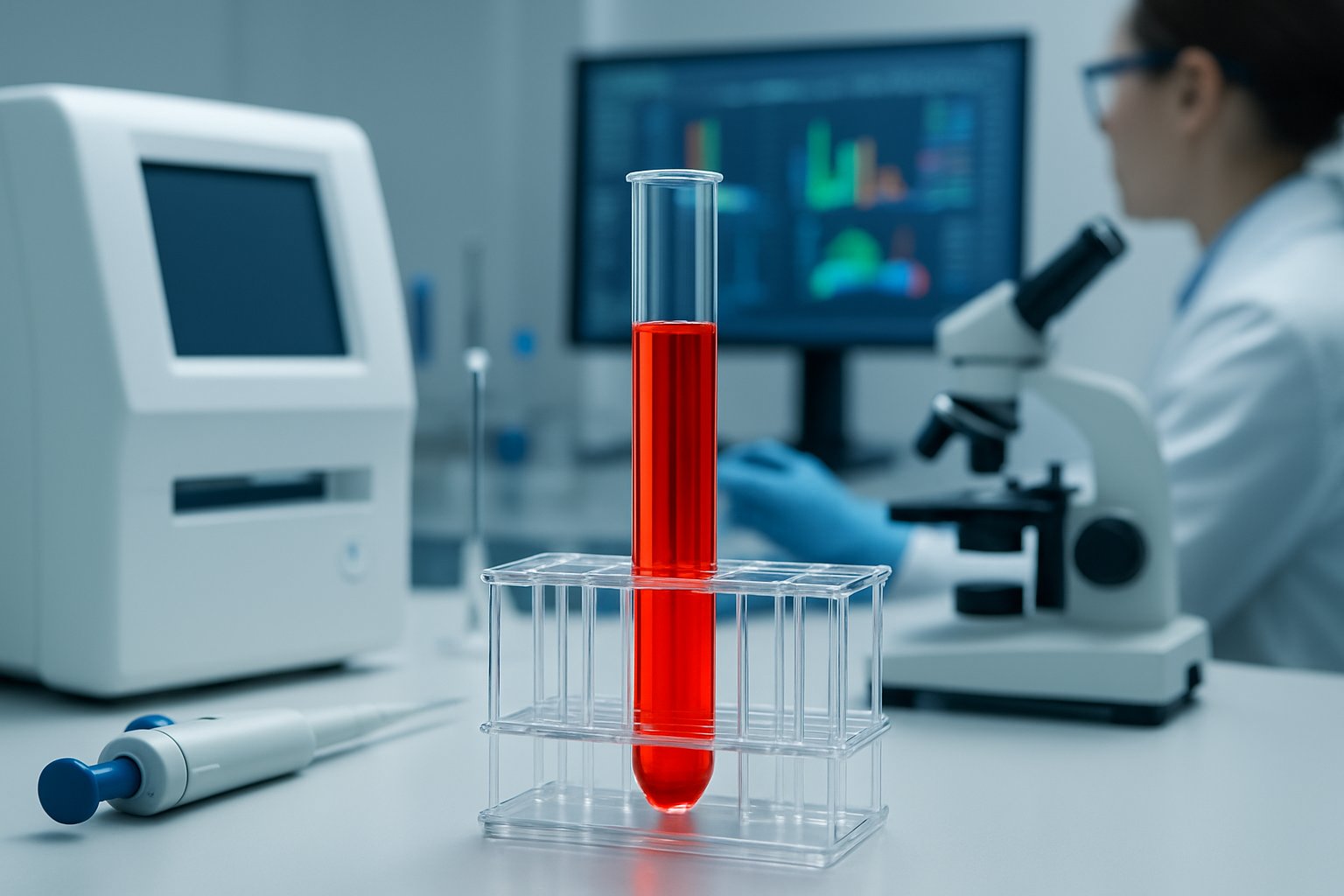High sodium levels in your blood can cause serious health problems ranging from mild symptoms like thirst and weakness to severe complications including confusion and seizures. When sodium levels rise too high, it usually means your body doesn’t have enough water to properly balance the salt, often caused by dehydration rather than eating too much salt.

Most people naturally drink more water when their sodium starts climbing, but certain groups face higher risks. Children, older adults, and people with medical conditions may not recognize thirst signals or have trouble accessing fluids when needed.
High sodium levels can impact heart and brain health[1], making it important to understand the warning signs and get proper treatment. The good news is that most cases respond well to careful rehydration under medical supervision.
Key Takeaways
- High blood sodium typically results from dehydration rather than consuming too much salt
- Symptoms range from mild thirst and weakness to serious complications like seizures in severe cases
- Treatment involves careful rehydration, often requiring medical supervision to avoid dangerous rapid changes
Understanding High Sodium Levels

High sodium levels occur when the body contains too little water for the amount of sodium present. This condition disrupts normal electrolyte balance and can lead to serious health complications if left untreated.
What Is Hypernatremia
Hypernatremia is the medical term for elevated sodium levels in the blood[2]. This condition develops when water loss exceeds sodium loss in the body.
The condition typically results from dehydration rather than eating too much salt. Common causes include not drinking enough fluids, vomiting, diarrhea, and excessive sweating.
Primary causes of hypernatremia:
- Insufficient water intake
- Excessive fluid loss through sweating
- Medications that increase urination
- Kidney disorders
- Diabetes with high blood sugar levels
Hypernatremia is most common in older adults. Their bodies may have difficulty maintaining proper water balance.
How Sodium and Electrolyte Balance Works
Sodium is one of the body’s key electrolytes. These are minerals that carry an electric charge when dissolved in blood and other body fluids.
The body carefully maintains water balance through several mechanisms. Healthy kidneys can handle wide variations in fluid intake when functioning normally.
Key functions of sodium include:
- Regulating fluid balance
- Supporting nerve function
- Maintaining blood pressure
- Controlling muscle contractions
The body needs at least 6 glasses of fluid daily to maintain proper water balance. This includes water from beverages and foods like fruits and vegetables.
When sodium concentration becomes too high, the brain triggers thirst signals. The kidneys also work to conserve water and restore normal electrolyte levels.
Normal Sodium Concentration Range
Normal sodium levels range between 135 and 145 mEq/L[1] in blood tests. Values above 145 mEq/L indicate hypernatremia.
Healthcare providers use blood tests to measure exact sodium concentration levels. These tests help determine the severity of the condition.
Sodium level classifications:
| Condition | Sodium Level (mEq/L) |
|---|---|
| Normal | 135-145 |
| Mild hypernatremia | 146-149 |
| Moderate hypernatremia | 150-159 |
| Severe hypernatremia | 160+ |
Doctors may perform additional tests to identify the underlying cause. These can include urine concentration tests and fluid balance assessments.
Early detection through regular blood work helps prevent complications. Sodium blood tests are crucial for assessing electrolyte balance[1] in the body.
Causes of Elevated Sodium in the Blood

High sodium levels typically occur when the body loses too much water compared to sodium, or when medical conditions affect how the kidneys handle these substances. Dehydration plays the most important role[3] in most cases of elevated blood sodium.
Dehydration and Fluid Loss
Dehydration is the leading cause of high sodium levels. When people lose more water than sodium, the concentration of sodium in their blood increases.
Common ways the body loses fluids include:
- Sweating excessively during hot weather or intense exercise
- Vomiting from illness or food poisoning
- Diarrhea that continues for several days
- Increased urination from various medical conditions
Not drinking enough fluids[3] makes dehydration worse. Adults need at least 6 glasses of fluid daily to maintain proper water balance.
Fever increases fluid loss through sweating and faster breathing. This puts extra stress on the body’s water reserves.
Medical Conditions Affecting Sodium
Several medical conditions can cause high sodium levels by affecting how the body processes water and salt.
Diabetes insipidus causes people to urinate large amounts frequently. This condition happens when the body cannot properly control water balance.
Kidney disease can prevent the kidneys from filtering sodium and water correctly. The kidneys may struggle to maintain the right balance of these substances.
Diuretic medications increase urination and can lead to excessive water loss. These drugs help treat high blood pressure and heart failure but may cause sodium imbalances.
People with diabetes and high blood sugar levels may urinate excessively. This leads to dehydration and elevated sodium[3].
Excessive Sodium Intake
Eating or receiving too much sodium can raise blood levels, though this happens less often than dehydration.
Hospital patients sometimes receive too much salt through IV fluids or medications. Medical staff monitor sodium levels closely to prevent this problem.
High-sodium diets rarely cause dangerous blood levels in healthy people. The kidneys usually handle extra sodium well when fluid intake is adequate.
Salt tablets or supplements can contribute to high sodium if taken incorrectly. People should only use these products under medical supervision.
Older Adults and At-Risk Groups
Older adults face the highest risk for elevated sodium levels. Their bodies handle fluid changes less effectively than younger people.
Age-related changes include:
- Reduced kidney function
- Decreased thirst sensation
- Lower total body water content
- More sensitivity to medications
Hypernatremia occurs most commonly among older adults[3] because of these factors.
People with mental impairments may forget to drink enough fluids. They also may not recognize thirst signals properly.
Those taking multiple medications face higher risks. Diuretics and other drugs can interact to cause fluid imbalances.
Recognizing Symptoms of High Sodium

High sodium levels often develop gradually, making early symptoms easy to miss. The body may initially compensate for elevated sodium, but as levels rise, symptoms become more serious and can lead to life-threatening complications.
Early Warning Signs
The first signs of high sodium are often mild and develop slowly. Many people don’t notice these early symptoms because they seem like common health issues.
Increased thirst is usually the first symptom people experience. The body tries to balance high sodium levels by triggering the urge to drink more water.
Mild nausea may occur as sodium levels begin to rise. This symptom often gets overlooked because it can have many causes.
Restlessness and feeling uncomfortable are common early signs. People may feel fidgety or unable to relax without knowing why.
Slight muscle weakness might develop, especially in the arms and legs. This weakness is usually mild at first but can worsen over time.
These early symptoms are the body’s way of signaling that sodium levels are climbing. Catching hypernatremia at this stage makes treatment much easier and more effective.
Progressive and Severe Symptoms
As sodium levels continue to rise, symptoms of hypernatremia[4] become more noticeable and concerning. The body struggles more to maintain normal function.
Extreme thirst becomes overwhelming and constant. No amount of water seems to satisfy this intense need to drink.
Vomiting often develops and makes the problem worse. Losing fluids through vomiting raises sodium levels even higher.
Confusion and mental changes become apparent. People may have trouble thinking clearly or remembering things.
Muscle twitching can start in the face, arms, or legs. These involuntary movements happen because high sodium affects nerve function.
Severe muscle weakness makes it hard to move normally. Simple tasks like walking or lifting objects become difficult.
Breathing changes may occur, with faster or more labored breathing patterns.
Complications of Untreated Hypernatremia
Without proper treatment, high sodium levels can cause serious and potentially deadly complications. The brain is especially vulnerable to damage from elevated sodium.
Seizures can occur when sodium levels reach dangerous heights. These happen because high sodium disrupts normal brain electrical activity.
Coma represents the most severe complication of untreated hypernatremia. The person becomes unconscious and unresponsive.
Brain bleeding is a life-threatening complication that can develop. High sodium causes brain cells to shrink[4], which can break blood vessels in the brain.
Permanent brain damage may result from severe hypernatremia. Even if treated, some people may have lasting neurological problems.
Death can occur in severe cases, especially in vulnerable populations like infants and elderly adults. Hospital patients with hypernatremia face higher risks of death compared to those with normal sodium levels.
Diagnosing High Sodium Levels

Doctors use blood tests to measure sodium levels[1] and additional tests to find the root cause. The diagnosis process involves checking electrolyte balance and kidney function to create the right treatment plan.
Blood Tests for Sodium
The main test for high sodium is a blood test that measures electrolyte levels. Normal sodium levels range between 135 and 145 mEq/L[1].
Doctors look for sodium levels above 145 mEq/L to diagnose hypernatremia. The blood test also checks other electrolytes like potassium and chloride.
Key blood test measurements:
- Sodium level: Above 145 mEq/L indicates hypernatremia
- Other electrolytes: Potassium, chloride, and bicarbonate
- Blood sugar: High levels can cause excessive urination
The blood test is simple and takes just a few minutes. Results usually come back within hours to help doctors start treatment quickly.
Urine Tests and Kidney Assessment
Urine tests help doctors understand how well the kidneys are working. These tests measure how much sodium the kidneys are removing from the body.
Doctors may measure urine volume and concentration[2] to check kidney function. High sodium in urine might mean the kidneys are working properly but the body is getting too much sodium.
Low sodium in urine could mean the kidneys are holding onto sodium to prevent further loss. This helps doctors figure out if dehydration or kidney problems are causing high blood sodium.
A water deprivation test may be used in some cases. This test checks how the kidneys respond when fluid intake stops for 12 hours.
Identifying Underlying Causes
Finding the cause of high sodium helps doctors choose the best treatment. Common causes include dehydration, kidney disease, and certain medications.
Medical history and physical examination[5] help identify potential causes. Doctors ask about fluid intake, medications, and recent illness.
Common causes doctors look for:
- Not drinking enough fluids
- Diarrhea or vomiting
- Diuretic medications
- Kidney disorders
- Diabetes with high blood sugar
Additional tests might include checking hormone levels that control water balance. Doctors may also review medications and supplements that contain sodium.
The physical exam checks for signs of dehydration like dry mouth and decreased skin elasticity. These findings help confirm the diagnosis and guide treatment decisions.
Treatment and Management of High Sodium
The treatment of hypernatremia[6] focuses on correcting the water deficit through careful fluid replacement and addressing the underlying cause. Medical supervision is essential because rapid correction can cause dangerous brain swelling.
Rehydration Approaches
Oral rehydration works best for mild cases when patients can drink fluids. Water alone helps restore balance, but drinking should happen slowly over several hours.
For moderate to severe cases, doctors use intravenous fluids. The most common options include:
- 5% dextrose in water – provides free water without extra sodium
- Half-normal saline (0.45% NaCl) – contains less sodium than blood
- Quarter-normal saline (0.225% NaCl) – for very high sodium levels
The keys to hypernatraemia management[7] include regular monitoring and adjusting fluid rates. Doctors calculate the water deficit using body weight and current sodium levels.
Correction rate matters. Sodium should drop no faster than 10-12 mEq/L per day. Too fast can cause brain cells to swell dangerously.
Medications and Medical Interventions
Stopping harmful medications comes first. Diuretics that cause water loss need adjustment or discontinuation. Salt tablets and high-sodium medications require review.
Diuretic medication changes depend on the cause. Loop diuretics like furosemide may worsen hypernatremia by causing more water loss than sodium loss. Doctors often reduce or stop these medications.
Desmopressin (DDAVP) helps when the problem involves inadequate hormone production. This medication helps the kidneys hold onto water better.
Dialysis becomes necessary in severe cases. This treatment can remove excess sodium while adding water back to restore proper water balance.
The kidneys play a key role in treatment success. Doctors assess kidney function to determine how well the body can process the replacement fluids.
Monitoring and Preventing Relapse
Blood tests every 4-6 hours track sodium levels during active treatment. Doctors adjust fluid rates based on these results to avoid overcorrection.
Daily weight checks help monitor fluid status. Weight gain shows successful rehydration, while continued weight loss suggests ongoing fluid losses.
Prevention strategies include:
- Adequate daily fluid intake (8-10 glasses for healthy adults)
- Regular medication reviews with healthcare providers
- Monitoring for early symptoms like increased thirst or confusion
Follow-up care involves checking sodium levels weekly until stable. Patients learn to recognize warning signs and maintain proper hydration habits.
Dietary changes may include reducing salt intake and increasing water-rich foods. Healthcare providers create individualized plans based on underlying health conditions and medications.
Reducing Risks and Supporting Recovery

Proper fluid management and targeted care for high-risk groups form the foundation of preventing complications from high sodium levels. Older adults and people with certain medical conditions need extra attention during recovery.
Managing Fluid Balance at Home
Water intake should increase gradually when sodium levels are elevated. Drinking 8-10 glasses of water daily helps the kidneys process excess sodium more effectively.
Plain water works best for most people. Sports drinks can add unnecessary sodium and should be avoided during recovery.
Monitor urine color as a simple indicator of hydration status:
- Pale yellow indicates good hydration
- Dark yellow suggests more fluids are needed
- Clear urine may signal overhydration
The kidneys need time to adjust sodium levels safely. Reducing sodium levels too rapidly can cause permanent brain damage[2], so gradual improvement is essential.
Dietary changes support recovery by limiting sodium intake to under 2,300 mg daily. Fresh fruits and vegetables naturally contain potassium, which helps balance sodium levels.
Avoid processed foods, canned soups, and restaurant meals during the initial recovery period. These items often contain hidden sodium that can slow progress.
Special Considerations for Vulnerable Populations
Older adults face higher risks because their kidneys process sodium less efficiently. Their thirst sensation also weakens with age, making dehydration more likely.
Caregivers should offer fluids regularly rather than waiting for requests. Set reminders every 2 hours during waking hours to encourage drinking.
People with diabetes insipidus require specialized medical supervision. This condition affects the body’s ability to conserve water, making fluid balance particularly challenging.
These patients may need prescription medications to help their kidneys retain water properly. Home monitoring becomes critical for tracking fluid intake and urine output.
Heart and kidney disease patients need modified approaches to fluid management. Too much fluid can strain these organs, while too little prevents proper sodium elimination.
Medical monitoring through blood tests[8] helps doctors adjust treatment plans safely for these high-risk individuals.
Frequently Asked Questions

High sodium levels require medical treatment and careful monitoring to prevent serious complications. The condition affects different groups of people in various ways and can result from multiple underlying causes.
How can you reduce elevated sodium levels in the blood?
Hypernatremia is treated by replacing fluids[3]. Doctors give dilute fluids through an IV in most cases.
The sodium level must be reduced slowly. Lowering it too fast can cause permanent brain damage.
Healthcare providers use carefully measured concentrations of water and small amounts of sodium. This gradual approach protects the brain from sudden changes.
What medical conditions can lead to increased sodium levels?
Diabetes mellitus with high blood sugar can cause excessive urination and dehydration. Kidney disorders also lead to fluid loss and sodium buildup.
Arginine vasopressin resistance causes people to urinate excessive amounts[3]. This happens when the body cannot properly use hormones that help kidneys save water.
Adrenal gland disorders can sometimes cause mild hypernatremia without dehydration. These conditions are less common but still require medical attention.
At what point does the concentration of sodium in the blood become hazardous?
Severe hypernatremia can lead to confusion, muscle twitching, seizures, coma, and death[3]. The most serious symptoms come from brain dysfunction.
Blood tests determine when sodium levels become dangerous. Doctors use these results to decide how quickly treatment needs to start.
Any level above normal requires medical evaluation. Early treatment prevents the condition from getting worse.
Why do older adults frequently have higher sodium levels?
Hypernatremia is most common among older adults[3]. Their bodies have a harder time keeping the right balance of water and sodium.
Older adults may not drink enough fluids during the day. They also take medications that can increase fluid loss.
Their kidneys may not work as well as they used to. This makes it harder for their bodies to save water when needed.
What are the typical treatment options for hypernatremia?
Fluid replacement is the main treatment for high sodium levels. Most patients receive IV fluids in a hospital setting.
Doctors may need to treat the underlying cause of the problem. This could include adjusting medications or managing diabetes.
The water deprivation test helps identify some causes[3]. This 12-hour test requires careful medical supervision because it can be dangerous.
Which symptoms might indicate excess sodium in the bloodstream?
Hypernatremia typically causes thirst[3]. This is usually the first sign people notice.
Brain-related symptoms include confusion and muscle twitches. These problems happen when sodium levels get very high.
Seizures can occur in severe cases. People may also experience changes in their mental state or level of consciousness.
References
- High sodium levels can impact heart and brain health. https://www.verywellhealth.com/sodium-blood-test-results-8674591 Accessed October 23, 2025
- Hypernatremia (High Level of Sodium in the Blood) - Hormonal and Metabolic Disorders. https://www.msdmanuals.com/home/hormonal-and-metabolic-disorders/electrolyte-balance/hypernatremia-high-level-of-sodium-in-the-blood Accessed October 23, 2025
- Hypernatremia (High Level of Sodium in the Blood) - Hormonal and Metabolic Disorders. https://www.merckmanuals.com/home/hormonal-and-metabolic-disorders/electrolyte-balance/hypernatremia-high-level-of-sodium-in-the-blood Accessed October 23, 2025
- symptoms of hypernatremia. https://www.verywellhealth.com/hypernatremia-overview-4772296 Accessed October 23, 2025
- Hypernatraemia (high sodium). https://www.kidneyresearchuk.org/conditions-symptoms/hypernatraemia/ Accessed October 23, 2025
- UpToDate. https://www.uptodate.com/contents/treatment-of-hypernatremia-in-adults Accessed October 23, 2025
- Hypernatraemia (Causes, Symptoms and Treatment). https://patient.info/doctor/investigations/hypernatraemia Accessed October 23, 2025
- 4 Ways To Keep Blood Sodium Levels Normal. https://thewell.northwell.edu/healthy-living-fitness/blood-sodium-levels Accessed October 23, 2025
